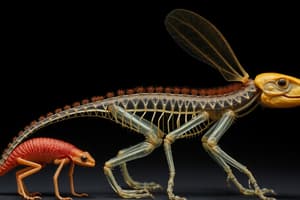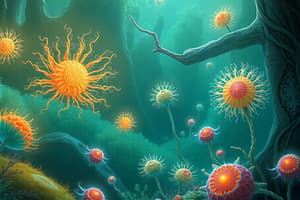Podcast
Questions and Answers
What type of locomotion do protozoans in the phylum Sarcodina primarily use?
What type of locomotion do protozoans in the phylum Sarcodina primarily use?
- Cilia
- Pseudopodia (correct)
- Cellular contraction
- Flagella
Which of the following statements about Mastigophora is incorrect?
Which of the following statements about Mastigophora is incorrect?
- They can cause diseases in humans.
- Some members are parasitic and pathogenic.
- They possess long flagella for movement.
- All members are free-living. (correct)
Which amoeba is known to cause amoebic dysentery in humans?
Which amoeba is known to cause amoebic dysentery in humans?
- Trypanosoma gambiense
- Foraminifera
- Entamoeba histolytica (correct)
- Amoeba proteus
What structure do shelled amoebas such as Foraminifera and Radiolaria possess?
What structure do shelled amoebas such as Foraminifera and Radiolaria possess?
How do amoebas primarily reproduce?
How do amoebas primarily reproduce?
What disease is caused by Trypanosoma gambiense?
What disease is caused by Trypanosoma gambiense?
Which of the following is NOT one of the main classifications of protozoans based on locomotion?
Which of the following is NOT one of the main classifications of protozoans based on locomotion?
What role do pseudopodia play in amoebas aside from locomotion?
What role do pseudopodia play in amoebas aside from locomotion?
What type of spore is produced by zygomycetes?
What type of spore is produced by zygomycetes?
Which of the following characteristics is true for Basidiomycetes?
Which of the following characteristics is true for Basidiomycetes?
Which fungi group has no known sexual reproduction?
Which fungi group has no known sexual reproduction?
What do Oomycetes have in common regarding their cell wall composition?
What do Oomycetes have in common regarding their cell wall composition?
What is a characteristic feature of the hyphae in Zygomycetes?
What is a characteristic feature of the hyphae in Zygomycetes?
What is the primary habitat of most algae?
What is the primary habitat of most algae?
Which of the following is NOT a typical member of the Basidiomycetes?
Which of the following is NOT a typical member of the Basidiomycetes?
Which fungi type is known for forming mutualistic associations with plant roots?
Which fungi type is known for forming mutualistic associations with plant roots?
What does the term 'eukaryote' literally mean in Greek?
What does the term 'eukaryote' literally mean in Greek?
Which of the following best describes the size comparison between eukaryotic and prokaryotic cells?
Which of the following best describes the size comparison between eukaryotic and prokaryotic cells?
What structure in eukaryotic cells separates chromosomal DNA during nuclear division?
What structure in eukaryotic cells separates chromosomal DNA during nuclear division?
Which organelle is involved in aerobic respiration in eukaryotic cells?
Which organelle is involved in aerobic respiration in eukaryotic cells?
Which organelle contains enzymes for the breakdown of hydrogen peroxide?
Which organelle contains enzymes for the breakdown of hydrogen peroxide?
What is the primary role of the cytoskeleton in eukaryotic cells?
What is the primary role of the cytoskeleton in eukaryotic cells?
Which of the following organelles contains most of the genetic material in a eukaryotic cell?
Which of the following organelles contains most of the genetic material in a eukaryotic cell?
What function does the endoplasmic reticulum serve in eukaryotic cells?
What function does the endoplasmic reticulum serve in eukaryotic cells?
What pigment is primarily responsible for the brown color in brown algae?
What pigment is primarily responsible for the brown color in brown algae?
Which characteristic distinguishes protozoans from algae?
Which characteristic distinguishes protozoans from algae?
What type of carbohydrate do dinoflagellates use for energy storage?
What type of carbohydrate do dinoflagellates use for energy storage?
What is the composition of the cell walls in brown algae?
What is the composition of the cell walls in brown algae?
Which pigment is NOT found in red algae?
Which pigment is NOT found in red algae?
How do protozoans primarily obtain their nutrients?
How do protozoans primarily obtain their nutrients?
Which of the following is a typical member of the dinoflagellates?
Which of the following is a typical member of the dinoflagellates?
Which storage carbohydrate is specific to brown algae and not found in dinoflagellates?
Which storage carbohydrate is specific to brown algae and not found in dinoflagellates?
Which of the following diseases is caused by a member of the Mastigophora?
Which of the following diseases is caused by a member of the Mastigophora?
What is the function of the macronucleus in ciliates?
What is the function of the macronucleus in ciliates?
Which of the following protozoans is known to cause dysentery in humans?
Which of the following protozoans is known to cause dysentery in humans?
What distinguishes the Apicomplexa class of protozoans from others?
What distinguishes the Apicomplexa class of protozoans from others?
Which of the following structures is present in most ciliates and aids in food ingestion?
Which of the following structures is present in most ciliates and aids in food ingestion?
Which organism is primarily responsible for transmitting malaria to humans?
Which organism is primarily responsible for transmitting malaria to humans?
What role do trichocysts serve in ciliates?
What role do trichocysts serve in ciliates?
Which of the following statements is true regarding sporozoans?
Which of the following statements is true regarding sporozoans?
Flashcards are hidden until you start studying
Study Notes
Eukaryotes
- Eukaryotes have complex cells with membrane-bound nuclei containing genetic material.
- The term "eukaryote" translates to "true nucleus," originating from Greek.
- Eukaryotes include multicellular organisms (animals, plants, fungi, algae) and unicellular organisms (yeasts).
- Eukaryotic cells are generally larger than prokaryotic cells, with distinct internal organelles.
- A cytoskeleton made of microtubules, microfilaments, and intermediate filaments supports cell structure.
Organelles
- Nucleus: Most prominent organelle, contains DNA in the form of linear chromosomes, separated during cell division by microtubular spindles.
- Mitochondria: Double-membraned organelles where aerobic respiration occurs; contain their own DNA.
- Lysosomes: Organelles that house enzymes for food breakdown.
- Peroxisomes: Contain catalase for converting hydrogen peroxide into water and oxygen.
- Endoplasmic Reticulum (ER) & Ribosomes: Involved in protein production; the Golgi apparatus processes these proteins.
Fungi
-
Zygomycetes (e.g., Mucor, Rhizopus):
- Aseptate (coenocytic) hyphae, zygospores as sexual spores, resistant to adverse conditions, form mycorrhizal associations with plants.
-
Basidiomycetes (Club fungi, e.g., Agaricus, Amanita):
- Septate hyphae, basidiospores produced on basidia; includes mushrooms and plant pathogens like rusts and smuts.
-
Oomycetes (Water Moulds, e.g., Albuginales):
- Aseptate hyphae; thick-walled oospores as sexual spores; cell walls made of cellulose, some aquatic.
-
Deuteromycetes (Fungi Imperfecti):
- Septate hyphae; only known to reproduce asexually; typical members include Penicillium, Aspergillus, Candida.
Algae
-
Algae are photosynthetic eukaryotes, primarily aquatic, with some terrestrial species.
-
Photosynthetic pigments include chlorophylls a and c, along with xanthophylls.
-
Carbohydrates are stored as starch; cellulose constitutes their cell walls.
-
Phylum Phaeophyta (Brown Algae):
- Multicellular organisms, pigments include chlorophylls a and c, fucoxanthin; store carbohydrates as laminarin.
-
Phylum Rhodophyta (Red Algae):
- Mostly multicellular, pigments include chlorophylls a and d, phycocyanin, and phycoerythrin; store carbohydrates as starch.
Protozoa
-
Protozoans are diverse, unicellular eukaryotes that are non-photosynthetic and generally heterotrophic.
-
Lack cellulose cell walls, commonly found in aquatic environments; many are parasitic, causing diseases in humans.
-
Protozoans reproduce mainly through phagocytosis, engulfing food particles, and some possess specialized structures like gullets.
-
Sarcodina (Amoebas):
- Characterized by pseudopodia; reproduce by binary fission; some are parasites (e.g., Entamoeba histolytica).
-
Mastigophora (Flagellates):
- Feature long flagella for movement; includes pathogenic species such as Trypanosoma gambiense (African sleeping sickness).
-
Ciliophora (Ciliates):
- Possess cilia for movement and feeding; exhibit two types of nuclei; Paramecium is a well-known example, while Balantidium coli causes dysentery.
-
Apicomplexa (Sporozoans):
- Obligate parasites, typically non-motile; Plasmodium causes malaria, transmitted by Anopheles mosquitoes; Toxoplasma leads to toxoplasmosis.
Studying That Suits You
Use AI to generate personalized quizzes and flashcards to suit your learning preferences.




